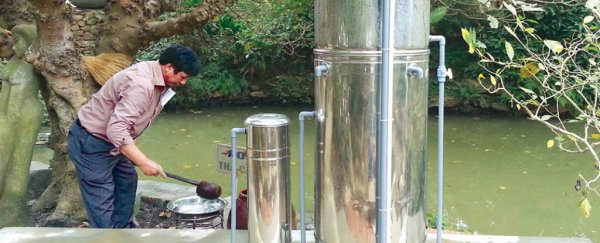Arsenic poisoning from drinking water is still a health concern for 137 million people in more than 70 countries around the world.
But a new filtration system created by Australian researchers could be the cheap and easy technology required to help solve this huge health issue - and best of all, it can be made using recycled parts.
Current systems for removing arsenic from ground water, such as reverse osmosis or iron exchange, aren't cost effective or efficient, which means they're not much use in the countries that really need them, like Vietnam and Bangladesh.
The University of Technology Sydney (UTS) team behind the new filter explains that because arsenic poising is such a slow process, many people without an alternative end up drinking the water anyway.
Eventually, they can suffer from various types of cancer or gastrointestinal disorders, creating a huge public health problem.
Working with the Vietnam National University, Vietnam Academy of Science and Technology, and local Vietnamese partners, the UTS scientists have come up with a new design that's affordable, and simple to create.
"There are three key components to this system: an organic membrane, a tank/drum in which the membrane is inserted, and an absorptive cartridge made from locally available industrial waste products," said lead researcher, Saravanamuth Vigneswaran.
"This sustainable system will both maximise locally sourced resources and minimise arsenic waste and environmental pollution, improving health and quality of life."
The membrane - basically a type of selective barrier - will also remove bacteria and solids from the contaminated groundwater, which means the finished product will be clean and safe to drink.
"The filtration can be powered by gravity or solar or by hand pump. Membranes will last up to three years, while the cartridges absorb the arsenic and are periodically replaced with new ones (every three to six months)," said Vigneswaran.
"The waste cartridges will be turned into safe building materials, so the system safely disposes of arsenic waste."
The team say that their product can be produced, installed, and maintained by local manufacturers – meaning once it's been introduced to the region, it will also create jobs for locals.
The researchers have been working on this project for the past few years, and have produced a number of papers about their results, which can be found here.
And they've just won a Technology Against Poverty prize to support and continue turning their work into reality.
The AU $500,000 prize is a partnership between innovationXchange and Google.
We're looking forward to seeing where this will lead - watch this space.
UTS Science is a sponsor of ScienceAlert. Find out more about their research.
